 |
surfresearch.com.au
glossary : f |
| home | catalogue | history | references | appendix |
|
|
|
|
|
|
|
|
|
|
|
|
|
|
|
|
|
|
|
|
|
|
|
|
|
|
|
|
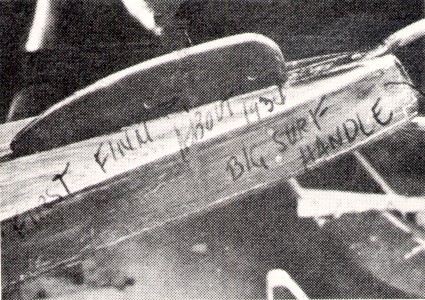 |
circa 1934
Tom Blake's Nub - Keel Fin solid timber 2 x 12 b @ 4 inches (Approximation) Tom Blake's first fin with Big Surf Handle Photograph and hand written caption by Tom Blake. Surfer Magazine,
See Fin Catalogue |
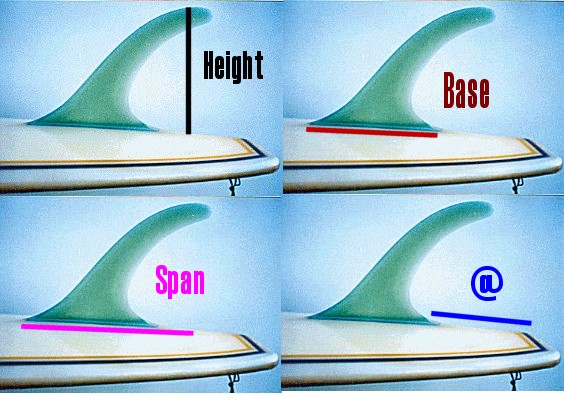 |
HEIGHT
(INCHES)
BASE
(INCHES)
SPAN
(INCHES)
@ (INCHES) FROM TAIL |
Apparently there was some
experimentation
was during the solid wood era. but the most significant
application were
experiments in the mid-1940's by George Downing and Wally
Froiseth in Hawaii.
They made a test board with a
removable
fin slot and rode it, as a control, without a fin and then with different fin designs in different
positions.
Their conclusion was that the finned
board
had superior performance, virtually regardless of fin design.
(Kelly,
page 121)
The first production models appeared
in
the early 1960’s in the USA.
Since many boxes were limited to the
manufacturers'
sole fin design, the impetus to manufacture boxed boards was
enhanced by
the cost advantages in freighting finless surfboards.
This was certainly a consideration
for
the larger Californian manufacturers in the mid-1960's, for whom
the East
coast was a major market.
At first fins were not universally
interchangeable
as each manufacturer used a different locking system, but in in
1965 Tom
Morey at Morey-Pope Surfboards developed the TRAF
system of
molded fins, available to a small number of Northern California
board makers.
In 1966 the design was improved by
the
introduction of thr Wonder Bolt system, again by Tom
Morey.
In February 1968 Morey introduced the
Waveset
box and a range of molded fins for general use.
This design was essentially copied by
the Safe Set system.
The most popular and significant fin
designs
were by George Greenough
who
produced three models for Waveset - Stage I, III and IV.
In the late 1960's, continuing reductions in board dimensions saw
extensive
fin design experimentation, with some designers focusing on
sideslipping,
note Skipp Frye's New-e-free fins, circa 1969.
The original Waveset box was too bulky relative to the smaller
boards
and circa 1970 it was updated with a male notched fin base
slotting and
locking into a molded female box.
This design was replicated by Guidance Fin System and
other
manufacturers.
In 1971 Bill Bahne (USA) introduced
his
Fins Unlimited fin box, that by 1974 was to become universally
adopted
and replicated.
It is still in current use.
It's huge success was a direct result
of the box's ability to accept laminated fibreglass fins of a
multitude
of designs.
Note that ...
- many riders considered the
fibreglass
fins superior in performance to molded plastic.
- the fibreglass fins could be
manufactured
by any experienced laminator.
- the fibreglass fins could be easily
reshaped and repaired.
- they were interchangable with
boards
from different manufacturers.
In Australia in the early 1970's
Bahne's
design was manufactured in fibreglass (see #83),
but this was shortlived as the large scale production of molded
boxes substantially
reduced the unit price.
In 1974 an Australian company, Wakefield
Surfboards, unsuccessfully
attempted to
market an aluminium model.
With an expanding number of fin
designs
in the late 1970's for kneeboards, waveskis and the twin-tin
surfboard,
boxes were available in a variety of lengths to either fit small
based
fins or allow maximum variation in fin placement.
Many Thruster designs of the
early1980's
featured two fixed side fins and a short centre fin box to allow
the rider
some variation in fin selection and placement.
In the 1980's the fin box was an
important
feature of sailboard design.
They allowed extensive fin
experimentation
and were also fitted into the deck as the mast track.
As surfboards became finer and
thinner
in the late 1980's the use of fin boxes in shortboards almost
disappeared,
but in the early 1990's a fin plug system for surfboards.was
developed
(initially by FCS, subsequently by others).
Further developments in the 1990’s
include
bolt-through boxes for sailboards (Tuttle, USA and
others).
Revised and updated May 2006, thanks
to
Nick Van Bruggen.
| flyers /
wings -
extremities, usually at the tail, in the template that greatly reduce width over a short distance. First adapted from rail side fins on a bellyboard by Bunker Spreckles circa 1972. Flyers normally retain the rail thickness – compare wings.\\ SURFER Volume 13# Number 3 September 1972 There are NO flyers in MOTE. Terry Fitzgerald noted for developing flyers in Australia late in 1972 after his time with Brewer and a chance sighting of Bunker Spreckles winger contraption during the Hawaiian winter of 1971-1972 (from which we get that massively inspirational sequence of Fitz at Rocky Point) did not commercially advertise flyers (orig named wingers) until 1973. Unusual
stepped-deck flyer swallow tail by Kuda Surfboards,
1975.
Designed and shaped by M. Crisdale, No. 1001 |
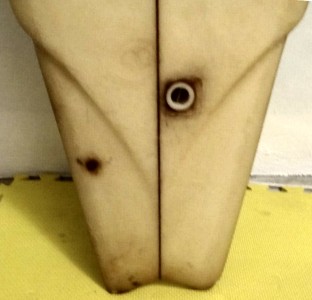 |
| Foil, The
Model name of Keith Paull design for Bing Surfboards (USA), 1968-9. Designed by Keith Paull, circa 1968 - 1970 Usually 7 to 8 ft, pin nose, round tail. Commonly Waveset fin box and moulded plastic fin. Commonly Australia theme logo |
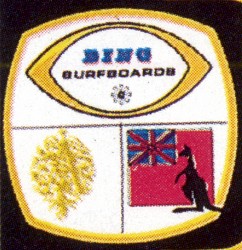 |
| Football fin
S-shaped fin with a narrow base, originally a sailboard fin design, circa 1983. Surfboard adaptation credited to Bobby Owens (Hawaii). |
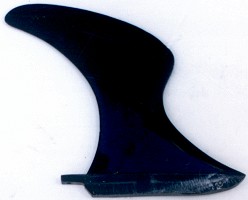 |

|
|
|
|
|
|
|
|
|
|
|
|
|
|
|
|
|
|
|
|
|
|
|
|
|
|
|
| home | catalogue | history | references | appendix |